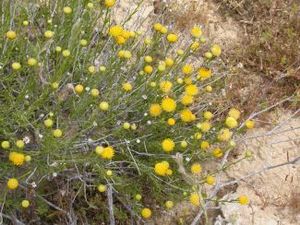Yellow mock aster facts for kids
Quick facts for kids Yellow mock aster |
|
|---|---|
 |
|
| Scientific classification | |
| Kingdom: | |
| (unranked): | |
| (unranked): | |
| (unranked): | |
| Order: | |
| Family: | |
| Genus: |
Eastwoodia
Brandegee
|
| Species: |
E. elegans
|
| Binomial name | |
| Eastwoodia elegans Brandegee
|
|
Eastwoodia is a special type of plant found in North America. It belongs to the sunflower family, which is a very large group of flowering plants. There is only one known species in this group, called Eastwoodia elegans. People often call it the yellow mock aster or yellow aster because its flowers look a bit like asters and are bright yellow. This plant is only found in California, meaning it is endemic to that state. You can spot it growing on grasslands and hillsides in central California, from the Bay Area all the way south to the Tehachapis.
Contents
What Does the Yellow Mock Aster Look Like?
The Eastwoodia elegans is a type of shrub. This means it's a woody plant that is smaller than a tree and often has many stems.
Stems and Leaves
- The plant grows several stems that stand straight up and have branches.
- These stems can reach up to 100 centimeters (about 40 inches) tall.
- The stems have bark that tends to peel or shred.
- Its leaves are small, usually less than 5 centimeters (about 2 inches) long.
Flowers and Blooms
- Each plant can produce many yellow flower heads.
- These flower heads are made up of many tiny flowers called disc florets.
- A single flower head can have as many as 40 disc florets.
- Unlike some other plants in the sunflower family, the yellow mock aster does not have ray florets. Ray florets are the petal-like parts you see on a daisy or sunflower.
How Did It Get Its Name?
The genus Eastwoodia was named after a famous botanist. A botanist is a scientist who studies plants.
Alice Eastwood: A Plant Explorer
- The plant was named to honor Alice Eastwood (1859–1953).
- She was a Canadian-American botanist who spent much of her life studying plants.
- Naming a plant after someone is a way to remember their important contributions to science.

